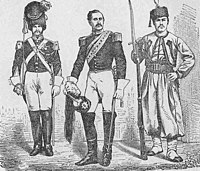User:Devink/sandbox4: Difference between revisions
No edit summary |
No edit summary |
||
| Line 47: | Line 47: | ||
===Collapse of Velikoslavia=== | ===Collapse of Velikoslavia=== | ||
[[File:Battle of Mišar, Afanasij Scheloumoff.jpg|200px|thumb|Hvrotzi Revolution]] | [[File:Battle of Mišar, Afanasij Scheloumoff.jpg|200px|thumb|Hvrotzi Revolution]] | ||
From the 1770s to 1802, Eastern Belisaria was engulfed in a period of warfare now known as the [[Thirty Years War]], a clash of empires between [[Velikoslavia]] in the west and [[Mesogeia]] in the east. The Velikoslavian Empire was a collection of feudal entities, autonomous regions, and local republics and the system that held all of those lands together collapsed during this era of warfare. War debts limited the ability of the crown to buy loyalties, the violence and pointlessness of the war, including the drafts, war taxes, and dissidents repressions, disillusioned many on the Empire and accustomed local people to take the matter of their defense and finances into their own hand. As peace settled in and the imperial government wished to re-establish its absolute control over all its lands, those free republics revolted and began fighting first for their autonomy in a constitutional empire and then, as the political doors for this solution closed one after the other, for full independence. | |||
===Ludvosiyan Religious persecutions=== | ===Ludvosiyan Religious persecutions=== | ||
[[File:Jewish pogrom in Kiev (1881).jpg|200px|thumb|Anti-cleric persecution in Ludvosiya]] | [[File:Jewish pogrom in Kiev (1881).jpg|200px|thumb|Anti-cleric persecution in Ludvosiya]] | ||
Revision as of 06:56, 14 August 2023
| Drevstran Intervention in Ludvosiya | |||
|---|---|---|---|
| Part of Ludvosiyan Wars | |||
 | |||
| |||
| Belligerents | |||
| Drevstran | Ludvosiya | ||
| Commanders and leaders | |||
|
| |||
Drevstran Intervention in Ludvosiya, or Farza VII War, was a conflict between the recently-created Triplpe-Crown of Drevstran and the Ludvosiyan Commonwealth that lasted from 1814 to 1841. It can be divided into three phrases: the initial naval campaign and the occupation of Hvratztan and Arazija lake ports, the invasion and military campaigns in the aforementioned republics, and finally the decades-long siege of the port-cities until finally a peace treaty was signed between the belligerents and the Drevstraneses garrisons were evacuated.
Farza VII War is generally counted among the Ludvosiyan Wars, a series of post-independence conflicts that saw the Commonwealth fight against all of its neighbors at one point or another with the survival of the Free Republics on the line. The Drevstranese Intervention itself was triggered by Ludvosiya' anti-clericalism and religious purges, and aimed to protect the Aletheic Church and re-establish the Arch-Presbyter of Kulpanitsa over coastal Hvratztan, all Arazija, and Drevstran as it had been under the Velikoslavian Empire. Drevstran' goal in the war shifted over the years, depending on military successes and defeats, but the religious question remained the main diplomatic concern of the Triple-Crown.
During the war, the Island Republic of Zostro would remain part of Ludvosiya despite being de-facto fully sovereign and treated as such by Drevstran who never invaded it over concerns in the human cost of a potential landing. Zostro de-facto neutrality helped secure its post-war position within the confederation notably in the shipmaking industry as its sister-republics naval sectors had been crippled by the occupation. The war, and the duality of Drevstran' diplomacy that was both trying to negotiate the return of religious freedom in Ludvosiya while also at time covertly supporting the Commonwealth against its other enemies, would be the baseline on which relations between the two states would be built later on, a mixture of defiance and temporary cooperation on specific questions, always with cold underlying tensions.
Before the War
Collapse of Velikoslavia
From the 1770s to 1802, Eastern Belisaria was engulfed in a period of warfare now known as the Thirty Years War, a clash of empires between Velikoslavia in the west and Mesogeia in the east. The Velikoslavian Empire was a collection of feudal entities, autonomous regions, and local republics and the system that held all of those lands together collapsed during this era of warfare. War debts limited the ability of the crown to buy loyalties, the violence and pointlessness of the war, including the drafts, war taxes, and dissidents repressions, disillusioned many on the Empire and accustomed local people to take the matter of their defense and finances into their own hand. As peace settled in and the imperial government wished to re-establish its absolute control over all its lands, those free republics revolted and began fighting first for their autonomy in a constitutional empire and then, as the political doors for this solution closed one after the other, for full independence.



